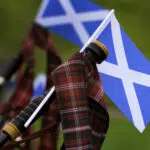History of St. Andrew's Day
St. Andrew's Day timeline
St. Andrew was among the apostles present at the last supper which was a pretty plum reservation to get. Try the wine.
As an apostle of Jesus Christ, St. Andrew meets a similar fate — crucified in Greece in 60 AD on a saltire, or a 'X' shaped cross.
Although St. Andrew was revered in Scotland from around 1000 AD, he was not made an official patron saint until the signing of the Declaration of Arbroath.
Scotland and Northern Ireland recognize St. Andrew's Day as a bank holiday, giving all Scots the opportunity to celebrate in full force.
St. Andrew's Day FAQs
Why do we celebrate St. Andrew's Day?
Is St. Andrew’s Day a public holiday?
What do you eat on St. Andrew's Day?
How to Observe St. Andrew's Day
Throw your own St. Andrew's feast
Gather your friends and feast on haggis, porridge, black pudding (ok, maybe leave that one out), and whisky! While you're at it, create some fun trivia about St. Andrew himself. Did you know he was a fisherman as well?
Wear a kilt
While it may not be a national holiday in America, we all can be Scots at heart. To celebrate St. Andrew's Day, wear a kilt, paint your face with a traditional blue saltire (better known as Scotland's flag), and call it a day!
Visit the town of St Andrews
If you're like us, then you're ready to book a one-way ticket to Scotland after learning how much fun it is to celebrate St. Andrew's Day. From November 30 to December 3, you can find the Scots celebrating across Europe, but it gets no better than in the town of St. Andrews itself, thanks to rolling landscapes, history, and tradition.
5 Odd St. Andrew's Eve Traditions You Won't Believe
Hiding grains to get a husband
In Romania it is tradition for young women to place 41 grains underneath their pillow, and if they dream their grains are stolen, then it's believed they will find a husband within the year.
How to guess your future husband's occupation
In Poland husbandless women believe they are able to predict their future husband's occupation by pouring hot wax through a keyhole into water — the wax forming to resemble the shape of their occupation.
The way to a man's heart is through food
In Slovakia young women write down the names of potential husbands on pieces of paper, kneading them into dough and baking; the first name to rise to the top of the bread will be their husband.
A curious way to get a girl's attention
In Moldova young men steal and hide gates or doors from the homes of the young women they wish to marry. In the morning the fathers' are tasked with finding their gates, thus knowing their daughter has a suitor.
One foot out of the door
In Austria young women throw a shoe over their shoulder; if it lands pointing towards the door they will be married within the year.
Why St. Andrew's Day is Important
This celebration is cause for a feast
In Scotland and across Europe, people celebrate St. Andrew's Day by feasting! May we suggest whipping up a meal of traditional haggis, neeps, and tatties (turnips and potatoes), and topping it off with a glass of Scottish whisky — straight?
Kilts are fun
Do we really need a reason to wear a kilt? No. Do we want a reason to wear a kilt? Absolutely. To celebrate, grab yourself a traditional Scottish kilt and never look back!
Whisky — and lots of it
Since St. Andrew's Day is considered Scotland's national holiday, Scots go all out with weeklong festivals, parties, and more. You can find a glass of whisky or beer in just about anybody's hand during the celebrations!
St. Andrew's Day dates
| Year | Date | Day |
|---|---|---|
| 2025 | November 30 | Sunday |
| 2026 | November 30 | Monday |
| 2027 | November 30 | Tuesday |
| 2028 | November 30 | Thursday |
| 2029 | November 30 | Friday |



















